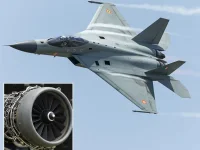- Views: 4K
- Replies: 19
The Gas Turbine Research Establishment (GTRE), a crucial part of India's Defence Research and Development Organisation (DRDO), is reportedly seeking approval to develop an upgraded Kaveri engine with a significantly increased thrust of 90kN.
This ambitious project aims to power the Tejas Mk1A fighter program and potentially the Tejas MkII, but it requires substantial advancements, including a completely redesigned core and significant funding.
The current Kaveri engine core can only produce 46-49kN of thrust, falling short of the requirements for next-generation fighter aircraft. To achieve the targeted 90kN thrust, the new Kaveri engine will need to deliver nearly 60kN of thrust in dry power, with afterburners providing the additional boost. This necessitates a new core capable of handling higher pressure and temperature ratios while maintaining reliability and efficiency.
Individuals involved in the program acknowledge the ambitious nature of this undertaking and the need for substantial funding and technological collaboration. The proposed engine is expected to build upon the lessons learned from the original Kaveri program while incorporating the latest advancements in material sciences, aerodynamics, and thermodynamics.
A key feature of the new Kaveri engine is its "flat-bed" design, which minimizes thrust loss across different flight conditions. This adaptability makes it suitable for both the Tejas Mk1A and the larger Tejas Mk2, which requires higher thrust for optimal performance.
Developing this new engine is a complex endeavor that could take several years, considering the intricacies of designing and testing such advanced machinery. However, with dedicated funding and strategic partnerships, the timeline could be accelerated.
A successful next-generation Kaveri engine would be a major achievement for India's indigenous defence industry, reducing reliance on foreign engine suppliers and powering its domestically developed fighter jets.




